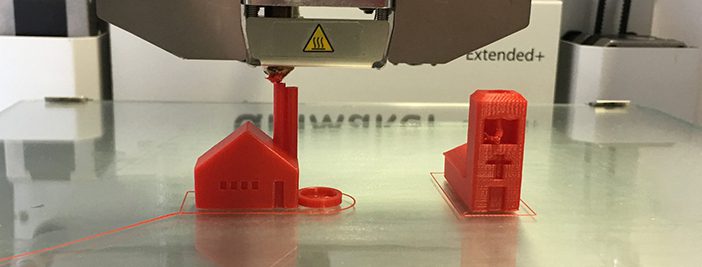[av_image src=’https://www.infinityinc.us/wp-content/uploads/BW-sq-1.jpg’ attachment=’8477′ attachment_size=’square’ align=’left’ styling=’circle’ hover=” link=” target=” caption=’yes’ font_size=’10’ appearance=’on-hover’ overlay_opacity=’0.6′ overlay_color=’#000000′ overlay_text_color=’#ffffff’ animation=’no-animation’ custom_class=” admin_preview_bg=” av_uid=’av-4bokvq’]
Brett,
Systems Engineer
[/av_image]
As a kid, I (like many) had a fascination with the Star Trek replicator. Fast forward a couple of decades and we have a basic version of that machine…kind of. 3D printing is available to anyone now with technology that is good and getting better daily.
For a few hundred dollars, you can get a solid quality beginner 3D printer such as the Ender 3, or any of its many clones, and start printing models! Sites like yeggi.com and cults3d.com offer a variety of models, many of which are free. This is one of those models I thought was just too cool and is now a decoration in my home.
Practical Uses for 3D Printers
But really that was just for fun. I like it, and it definitely matches my personality. But it doesn’t represent how practical 3D printing can be.
To explain how useful it can be, you should know my wife and I have chickens and quail. You should also know that a few chickens and quail lay a lot of eggs. And despite my healthy appetite, I just can’t eat them as fast as they can produce them. So we needed a method to store eggs neatly.
Here you can see some different “egg crates” and also a cool decorative bowl, all made by my 3D printer!
My wife also needed a basket to help bring the eggs in from the coop. She found one that was able to squish flat for easy storage!
Of course, these things are just a few among the many items you can find and print for free, minus the cost of filament. And filament, at roughly $20 per roll of PLA, is cheap. Did I mention PLA comes in a variety of colors that allows you to completely customize how the end product looks?
How 3D Printing Works
This is where this blog gets just a little bit nerdy. I’m going to use some acronyms to give you a basic understanding of how 3D printing works so that you know how to get started with all the ways you can imagine using it.
So PLA, or Polylactic Acid, filament is a recyclable, natural thermoplastic polyester derived from renewable resources such as corn starch or sugar cane. It has high heat capacity and high mechanical strength. It’s a great type of filament to start with, though there are other materials available depending on the sophistication of your 3D printer and the project you’re making.
Everything printed in the images above was designed in some form of CAD. CAD, if you are not already familiar, stands for Computer-Aided Design. Basically, it means you draw in a program that understands 3 dimensions—not just flat height and width, but depth, too.
Those drawings are then sent to another program called a slicer. The slicer then slices the 3D image into layers that will be sent to the 3D printer as instructions. The printer then reads those instructions, and layer by layer, builds the item that was designed in CAD.
Putting 3D Printing to Work for You
Now, what if I told you there was a way to turn real world 3D objects into things that you can print. Which brings us back to the replicator from Star Trek. Enter the 3D scanner and your smartphone!
This is a device I built with my 3D printer to scan objects in 3 dimensions. It works by placing the object you want to scan (the little hand) on the turn table. Then you turn the handle bit by bit while taking many pictures with the attached cell phone.
These pictures can then be assembled in software as a 3D image you can open in CAD. Within CAD, you can make any tweaks to the image you want, then send it to the slicer, then to the printer and voila! You have successfully replicated that object.
A Few Final Thoughts
What can you do with a 3D printer does somewhat depend on the type and quality of the 3D printer, along with your skill. So don’t expect to build yourself a house on your first attempt. But considering there is an industry that is now 3D printing meat, there’s really no limit to the possibilities.
And did you know that there is research into 3D printing organs for transplant?
The applications for this technology are truly incredible and still just being discovered. So if you’re interested in trying it out, let your imagination run wild. And if that seems overwhelming, then start small.
Think about what might be useful in your home, like my egg crates and basket. Or consider what you have at work that isn’t quite how you want it. Maybe you do handiwork and want to create your own jig for specific projects, or maybe you want to create something unique you can sell.
Just keep in mind that technology is a tool—this is a very cool one, granted, but a tool nonetheless. You can use it to unlock almost limitless possibilities…or it can be a bright, shiny object you briefly spend time and money on before letting it gather dust in the corner.
At Infinity, we live and breathe technology to help businesses save time and money. I love it so much, I explore 3D printing at home in my off time. If that sounds like you, maybe you should come work with me. And if it sounds like something you never want to do, then you might want Infinity to work for you.
